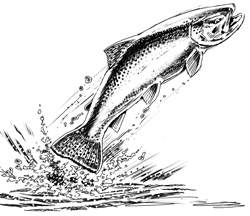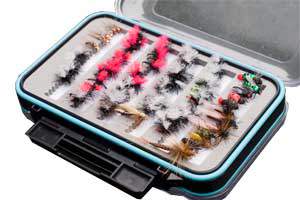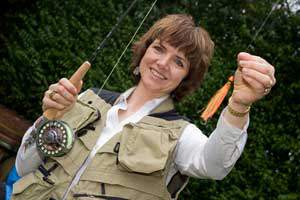Choosing Trout Fly Patterns
Choosing Your Trout Fly Patterns

 Fly patterns can be imitative flies like Caddis, damsel nymphs or Epoxy minnows to impressionistic flies like Gold Ribbed Hares Ear and Pheasant Tail fishing through to attractors like blobs and lures or streamers which do not look like anything natural but are patterns that trigger the Trout's predatory nature!
Fly patterns can be imitative flies like Caddis, damsel nymphs or Epoxy minnows to impressionistic flies like Gold Ribbed Hares Ear and Pheasant Tail fishing through to attractors like blobs and lures or streamers which do not look like anything natural but are patterns that trigger the Trout's predatory nature!
Key when choosing flies is to match the hatch where possible. Look at both the size and colour of the naturals and then match them with artificials where possible for both size and colour. Remember though you could use a Klinkhammer if of the appropriate colour and size, it does not necessarily have to exactly match the natural for size and shape. We are looking for trigger points in colour, size and shape which will simply get the Trout to react. If there is not much surface action then try kick sampling, looking at what is on the bottom of the water and match with nymphs, buzzers and terrestrial flies. We may in this case be using a bloodworm or a pheasant tail to match a baetis.
Artificial flies are created by tying hair, fur, feathers, or other fly tying materials, both natural and synthetic, onto a hook with thread. The first fishing flies were tied with natural fly tying materials, but synthetic materials are now extremely popular and prevalent. The fly fishing flies are tied in sizes, colors and patterns to match local terrestrial and aquatic insects, baitfish, or other prey attractive to the target fish species.
 In broadest terms, flies are categorized as either imitative or attractor. Imitative fishing flies resemble natural food items. Attractor flies trigger instinctive strikes by employing a range of characteristics that do not necessarily mimic prey items. Fly fishing flies can be fished floating on the surface (dry flies), partially submerged (emergers), or below the surface (nymphs, streamers, and wet flies.) A dry fly is typically thought to represent an insect landing on, falling on (terrestrials), or emerging from, the water's surface as might a grasshopper, dragonfly, mayfly, ant, beetle, stonefly or caddis fly. Other surface flies include poppers and hair bugs that might resemble mice, frogs, etc. Sub-surface flies are designed to resemble a wide variety of prey including aquatic insect larvae, nymphs and pupae, baitfish, crayfish, leeches, worms, etc. Streamers are generally thought to imitate minnows, leeches or scuds.
In broadest terms, flies are categorized as either imitative or attractor. Imitative fishing flies resemble natural food items. Attractor flies trigger instinctive strikes by employing a range of characteristics that do not necessarily mimic prey items. Fly fishing flies can be fished floating on the surface (dry flies), partially submerged (emergers), or below the surface (nymphs, streamers, and wet flies.) A dry fly is typically thought to represent an insect landing on, falling on (terrestrials), or emerging from, the water's surface as might a grasshopper, dragonfly, mayfly, ant, beetle, stonefly or caddis fly. Other surface flies include poppers and hair bugs that might resemble mice, frogs, etc. Sub-surface flies are designed to resemble a wide variety of prey including aquatic insect larvae, nymphs and pupae, baitfish, crayfish, leeches, worms, etc. Streamers are generally thought to imitate minnows, leeches or scuds.



















